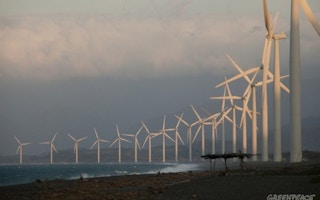Leading power distributor Manila Electric plans to venture into the renewable energy-generation business beginning with an investment in a potential 300-megawatt wind farm in Laoag, Ilocos Norte, the company’s chief executive said.
The entry into the renewable energy sector is part of Meralco’s plan to install 2,500 MW in new generation capacity between now and 2020, using part of the leeway allowed by the energy deregulation law for it to generate relative to its distribution volume, Meralco president Oscar Reyes told the Inquirer.
Reyes said Meralco was also looking at liquefied natural gas-fired plants for diversification purposes.
He added that Meralco was addressing the issues delaying the 600-MW coal-fired power plant project in Subic Bay freeport, which is being undertaken by subsidiary Meralco PowerGen through a joint-venture (Redondo Peninsula Energy) with the Aboitiz group.
“We’re also in discussions for a potential renewable facility in Laoag,” Reyes said, pointing out that more than 300 MW in capacity was being considered for the facility in Ilocos Norte.
Asked whether Meralco was happy with the recently approved feed-in-tariffs (FIT) for renewable energy, Reyes said the important thing would be to locate the renewable energy facility in an area considered robust in terms of efficiency and load factor so that it would be possible to make good returns even under competitive tariff rates.
“We would rather rely on an efficient plant for a return rather than (on) high feed-in tariff that involves some form of support from consumer,” Reyes said.
The Energy Regulatory Commission recently approved the much-awaited FIT rates for four renewable energy resources, which represents the subsidy consumers will bear to give incentives to the industry: P9.68 a kilowatt-hour for solar; P8.53/kWh for wind; P6.63/kWh for biomass; and P5.90/kWh for hydropower projects. The ERC deferred fixing the FIT rates for ocean thermal energy conversion resource for further study and data gathering.
“The more you get grid-competitive rate, the better it is for the consumer,” Reyes said.

















